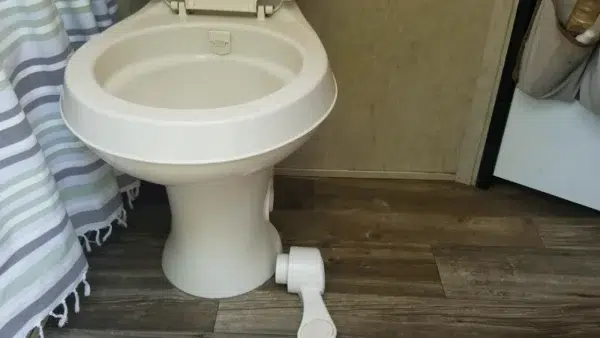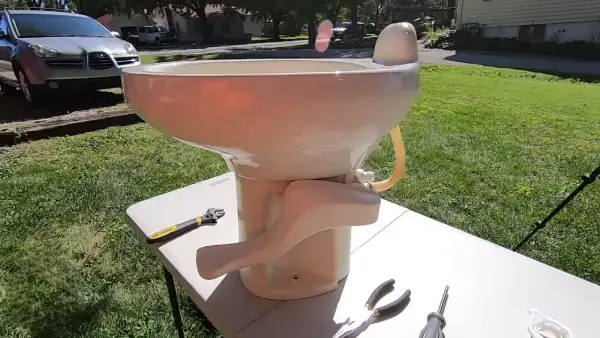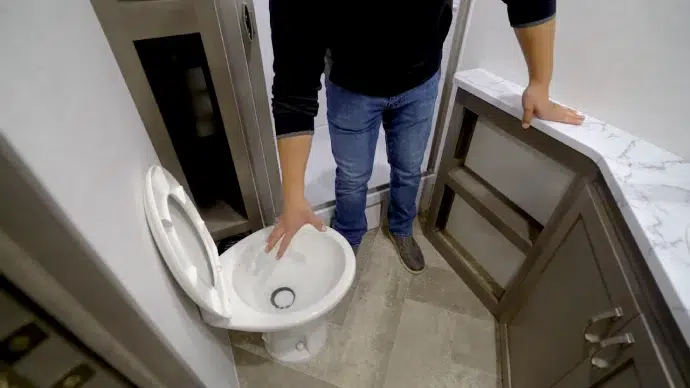Last Updated on April 5, 2023
Are you planning a road trip with your RV and wondering about the weight capacity of your toilet? One of the most frequently asked questions by RV enthusiasts is how much weight can an RV toilet support.
While it may seem like a trivial concern, it’s essential to know the answer to this question to prevent any mishaps on the road. Overloading an RV toilet can cause damage to the plumbing system, leading to costly repairs. It can also pose health risks due to harmful chemicals used in some types of RV toilets.
Here we’ll provide you with all the information you need to ensure that your RV’s bathroom facilities are safe and sound for everyone onboard. So sit tight and let’s dive into the fascinating world of RV toilets.
How Much Weight Can an RV Toilet Support: Average Capacity
The average weight capacity of RV toilets is an important consideration for any RV owner. While the weight capacity can vary depending on the type and brand of toilet, most RV toilets have a weight capacity ranging from 250 to 500 pounds.
Understanding the average weight capacity of your RV’s toilet is essential for preventing damage to both your plumbing system and your health. Using your toilet responsibly will help ensure that it continues to function correctly for years to come.
What Factors Affect RV Toilet Weight Capacity?

An RV toilet’s weight capacity can be affected by several factors.
Types of RV Toilets:
The first and most obvious factor is the type of toilet installed in the RV. There are three main types of RV toilets: cassette, gravity flush, macerating, and composting.
Cassette Toilets:
Cassette toilets have a removable holding tank that can be emptied at designated dump stations. These types of toilets are commonly found in smaller RVs or campervans. It can hold between 270 lbs to 350 lbs.
Gravity Flush Toilets:
Gravity flush toilets are the most common type found in RVs and use gravity to move the waste from the bowl into the holding tank below. These toilets typically have a weight capacity of around 300 pounds.
Macerating Toilets:
Macerating toilets use a motorized blade to grind up waste before it is moved into the holding tank. These toilets can handle heavier loads and have a weight capacity of around 500 pounds.
Composting Toilets:
Composting toilets do not use water and instead rely on natural processes to break down waste. These toilets have a weight capacity similar to gravity flush toilets at around 300 pounds.
Size and Strength of the Installation Hardware:
Aside from the type of toilet, other factors that can affect weight capacity include the size and strength of the mounting hardware used to secure the toilet to the floor. As well as any additional weight placed on top of or near the toilet, such as toiletries or cleaning supplies.
Materials for RV Toilets:
For instance, some toilets may be made with sturdier materials that can support more weight than others. Additionally, how securely the toilet is installed in the RV can also impact its weight capacity.
By understanding these factors affecting weight capacity, RV owners can ensure their toilet remains in good working condition for years to come while also promoting health and safety for all occupants of their vehicle.
Risks of Overloading an RV Toilet

Overloading an RV toilet can lead to serious risks and damages that can affect both the plumbing system and the health and safety of those using the RV. It is important to understand the risks associated with overloading an RV toilet and take necessary precautions to avoid any potential issues.
1. Damage to the RV Toilet and Plumbing System
Overloaded RV toilets can cause serious damage to the plumbing system. The weight capacity of a recreational vehicle toilet is limited, and exceeding this limit can lead to costly repairs.
When an RV toilet is overloaded, it puts excessive pressure on the seals and valves in the plumbing system. This can cause leaks, blockages, and even breakage. In addition, overloading the toilet can also damage the holding tank, which is responsible for storing waste until it can be properly disposed of.
2. Risks to Health and Safety
Overloading an RV toilet can pose serious risks to health and safety. Overloaded RV toilets may not properly dispose of waste. This can cause sewage buildup in the holding tank, leading to unpleasant odors and unsanitary conditions.
If the tank becomes too full, there is also a risk of leakage or overflow, which can create hazardous conditions both inside and outside the RV.
RV Toilet Maintenance Tips for Maintaining Their Default Weight Capacity

Proper maintenance of an RV toilet is essential to ensure its longevity and functionality. Here are some tips for maintaining your RV toilet:
1. Regular Cleaning and Maintenance
Regular RV toilet cleaning and maintenance ensure its proper functioning and longevity. To maintain your RV toilet, it’s important to clean it regularly.
You can use a mild cleaner specifically designed for RV toilets or a mixture of vinegar and baking soda. Avoid using harsh chemicals or abrasive cleaners that can damage the toilet’s seals and components.
In addition to regular cleaning, inspecting the toilet periodically for any signs of wear or damage is important. Check the seals around the base of the toilet and at the connection points for any cracks or leaks. If you notice any issues, address them promptly before they become bigger problems.
2. Proper Use and Disposal
Proper use and disposal of an RV toilet are essential for maintaining its longevity and avoiding any potential health hazards. Here are some tips to ensure proper use and disposal:
- Use RV-friendly toilet paper: Regular toilet paper can clog the plumbing system in an RV, causing damage and potentially costly repairs. It’s important to use RV-specific toilet paper that is designed to dissolve quickly.
- Don’t overuse chemicals: While it may be tempting to use excessive amounts of chemicals to mask odors, it’s important not to overdo it. Overuse of chemicals can damage the rubber seals in the toilet, causing leaks and potential health hazards.
- Empty the black water tank regularly: The black water tank is where all waste from the RV toilet goes. It’s important to empty this tank regularly, as leaving waste in there for too long can cause unpleasant odors and potential health hazards.
- Use a dump station: When it comes time to empty the black water tank, use a designated dump station rather than dumping it on the ground or in a regular toilet. Dump stations are designed for this purpose and will help prevent potential environmental damage.
How much does a porcelain RV toilet weigh?
A porcelain RV toilet can typically weigh anywhere between 30 to 50 pounds. This is because these toilets are made with a durable porcelain material built to last and withstand relatively high weight limits.
The exact weight of the toilet will depend on its size and design and the type of mountings used for installation. Additionally, some models may come with heavier accessories like steel hinges or seat bolts which can add extra weight.
How much weight can a floating RV toilet handle?

A floating RV toilet is designed to handle a maximum weight capacity of 200kg or 440 lbs. This means it can safely support an individual’s body weight and any additional items that may be placed on top, such as a toilet seat or lid.
It is important to always stay within the recommended weight capacity to ensure proper operation and avoid any potential damage or risk of injury. Regular inspection and maintenance should be performed to keep the toilet running optimally and prevent any further breakdowns.
How much weight can a standard RV toilet handle?
The weight capacity of a standard RV toilet is typically around 500 pounds. This is an important factor to consider when installing an RV toilet, as it needs to handle the weight of people and items placed on or near it.
RV toilets are designed to be lightweight yet strong enough to handle heavy loads without breaking or bending. Most models will feature adjustable feet that allow you to adjust the height and balance of the toilet for added stability.
What is the difference between an RV toilet and a regular toilet?
RV toilets are different from regular toilets in several ways. They do not require a water tank on the back as they flush using a press of a foot pedal rather than running off city water pressure.
Waste from the RV toilet disappears into a black water tank underneath the vehicle instead of going directly into sewers or septic tanks like regular toilets do. The size and shape of an RV toilet are typically smaller than those found in residential homes, which makes them more space-efficient for tight living quarters on RVs.
Discover the Capacity of Your RV Toilet and Avoid Risking Damage
Understanding the weight capacity of your RV toilet is crucial to maintaining a safe and healthy environment while on the road. Knowing the different types of RV toilets and how they work can help you decide which one is right for you.
Factors such as size, materials, and installation can all affect the RV toilet’s gross weight capacity. It is important to keep in mind that overloading your toilet can lead to serious damage to both the toilet and plumbing system, putting your health at risk.



